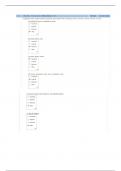Prüfung
Final Exam: NR606/ NR 606 (NEW Update 2024/ 2025) Diagnosis & Management in Psychiatric Mental Health II Practicum Review |Weeks 5-8 | Questions and Verified Answers| 100% Correct| A Grade- Chamberlain
- Kurs
- Hochschule
Final Exam: NR606/ NR 606 (NEW Update 2024/ 2025) Diagnosis & Management in Psychiatric Mental Health II Practicum Review |Weeks 5-8 | Questions and Verified Answers| 100% Correct| A Grade- Chamberlain QUESTION disruptive behavioral disorders Answer: -Disruptive, impulse-cont...
[ Mehr anzeigen ]












